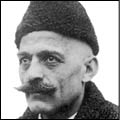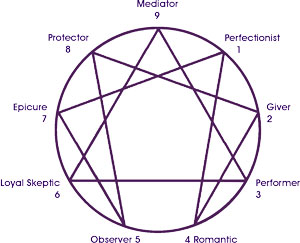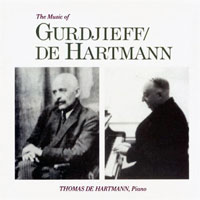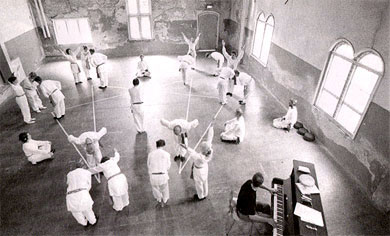[vc_row][vc_column width=”2/3″][vc_column_text]
 George Ivanovich Gurdjieff was born to a Greek father and Armenian mother in Alexandropol (now Gyumri, Armenia), then part of the Russian Empire. The Turks & Persians called Georgia “Gurjistan”, which may account for the root of the name “Gurdjieff”.
George Ivanovich Gurdjieff was born to a Greek father and Armenian mother in Alexandropol (now Gyumri, Armenia), then part of the Russian Empire. The Turks & Persians called Georgia “Gurjistan”, which may account for the root of the name “Gurdjieff”.
The exact date of his birth remains unknown (conjectures range from 1866 to 1877). Some authors (such as Moore) argue persuasively for 1866, others (like Patterson) for 1872; a passport gave a birthdate of November 28, 1877, but he stated that he was born at the stroke of midnight at the beginning of New Year’s Day (Julian calendar). Gurdjieff grew up in Kars and traveled to many parts of the world (such as Central Asia, Egypt and Rome) before returning to Russia for a few years in 1912. He later said: “Begin in Russia, end in Russia.”
The only account of Gurdjieff’s early life, before he appeared in Moscow in 1912, appears in his book Meetings with Remarkable Men. This text, however, cannot be read as straightforward autobiography. In the period before 1912, Gurdjieff went on the voyage outlined in Meetings with Remarkable Men where he came upon a map of “pre-sand Egypt” which led him to study with an esoteric group, the alleged Sarmoung Brotherhood.
From 1913 to 1949 the chronology appears to be based on material that can be confirmed by primary documents, independent witnesses, cross-references, and reasonable inference. On New Year’s Day in 1912, Gurdjieff arrived in Moscow and attracted his first students. In the same year he married the Polish Julia Ostrowska in St Petersburg. In 1914, Gurdjieff advertised his ballet, The Struggle of the Magicians, and supervised his pupils’ writing of the sketch “Glimpses of Truth”. In 1915, Gurdjieff accepted P. D. Ouspensky as a pupil, while in 1916 he accepted the composer Thomas de Hartmann and his wife Olga as students. At this time he had about 30 pupils.
In the midst of revolutionary upheaval in Russia, Gurdjieff left Petrograd in 1917 to return to his family home in Alexandropol. During the Bolshevik Revolution, he set up temporary study communities in Essentuki in the Caucasus, then in Tuapse, Maikop, Sochi and Poti, all on the Black Sea coast of southern Russia, where he worked intensively with many of his Russian pupils.
In March 1918, Ouspensky separated from Gurdjieff. Four months later, Gurdjieff’s eldest sister and her family reached him in Essentuki as refugees, informing him that Turks had shot his father in Alexandropol on 15 May (during the days of the Armenian Genocide in Ottoman Turkey). As Essentuki became more and more threatened by civil war, Gurdjieff put out a fabricated newspaper story announcing his forthcoming “scientific expedition” to Mount Induc. Posing as a scientist, Gurdjieff left Essentuki with fourteen companions (excluding Gurdjieff’s family and Ouspensky). They traveled by train to Maikop, where hostilities delayed them for three weeks. In spring 1919, Gurdjieff met the artist Alexandre Salzmann and his wife Jeanne and accepted them as pupils. Assisted by Jeanne Salzmann, Gurdjieff gave the first public demonstration of his Sacred Dances (Movements at the Tbilisi Opera House, 22 June).
In the autumn of 1919, Gurdjieff and his closest pupils moved to Tbilisi, formerly known as Tiflis. There Gurdjieff’s wife, Julia Ostrowska, Mr and Mrs Stjoernval, Mr and Mrs de Hartmann and Mr and Mrs de Salzmann gathered a lot of the fundamentals of his teaching. Gurdjieff concentrated on his still unstaged ballet, The Struggle of the Magicians; Thomas de Hartmann (who had made his debut years ago before as the Czar of All Russia) worked on the music for the ballet; and Olga Iovonovna Lazovich Milanoff Hinzenberg (who years later wed the American architect Frank Lloyd Wright) practiced the ballet dances. In 1919, Gurdjieff established his first Institute for the Harmonious Development of Man. He was thought to be greatly influenced by Niko Marr, a Georgian archaeologist and historian.
In late May 1920, when political conditions in Georgia changed and the old order was crumbling, his party traveled by foot to Batumi on the Black Sea coast and then to Istanbul. Gurdjieff rented an apartment on Koumbaradji Street in Péra, and later at 13 Abdullatif Yemeneci Sokak near the Galata Tower. The apartment is near the kha’neqa’h (monastery) of the Molavieh Order of Sufis (founded by Jalal al-Din Muhammad Rumi), where Gurdjieff, Ouspensky and Thomas de Hartmann experienced the sema ceremony of The Whirling Dervishes. In Istanbul, Gurdjieff also met Captain John G. Bennett, then head of British Military Intelligence in Constantinople. Later, Bennett would become a follower of Gurdjieff and of Ouspensky.

George Ivanovich Gurdjieff
In August 1921 and 1922, Gurdjieff traveled around western Europe, lecturing and giving demonstrations of his work in various cities, such as Berlin and London. He attracted the allegiance of Ouspensky’s many prominent pupils (notably the editor A. R. Orage). After he lost a civil action to acquire Hellerau possession in Britain, Gurdjieff established the Institute for the Harmonious Development of Man south of Paris at the Prieuré des Basses Loges in Fontainebleau-Avon near the famous Château de Fontainebleau. Gurdjieff acquired notoriety as “the man who killed Katherine Mansfield” after Katherine Mansfield died there of tuberculosis under his care on 9 January 1923. However, James Moore and Ouspensky convincingly show that Katherine Mansfield knew she would soon die, and that Gurdjieff made her last days happy and fulfilling.
Starting in 1924, Gurdjieff made visits to North America, where he eventually received the pupils taught previously by A.R. Orage. In 1924, while driving alone from Paris to Fontainebleau, he had a near-fatal car accident. Nursed by his wife and mother, he made a slow and painful recovery against medical expectation. Still convalescent, he formally “disbanded” his institute on 26 August (in fact he dispersed only his less-dedicated pupils) and began writing All and Everything.
In 1925 Gurdjieff’s wife developed cancer; she died in June 1926 in spite of radiotherapy and Gurdjieff’s magnetic treatments. Ouspensky attended her funeral. According to Fritz Peters, Gurdjieff was in New York from November 1925 to the spring of 1926, when he succeeded in raising over $100,000.
In 1935 Gurdjieff stopped writing All and Everything. He had completed the first two parts of the trilogy but only started on the Third Series. (It was later published under the title Life Is Real Only Then, When ‘I Am’). In Paris, Gurdjieff lived at 6 Rue des Colonels-Rénard, where he continued to teach throughout World War II.
Gurdjieff died on October 29, 1949 at the American Hospital in Neuilly-sur-Seine, France. His funeral took place at the St. Alexandre Nevsky Russian Orthodox Cathedral at 12 Rue Daru, Paris. He is buried in the cemetery at Fontainebleau-Avon.
Ideas
Gurdjieff claimed that people cannot perceive reality in their current states because they do not possess consciousness but rather live in a state of a hypnotic “waking sleep.”
[pull_quote_right]”Man lives his life in sleep, and in sleep he dies.”[/pull_quote_right]
As a result of this condition, each person perceives things from a completely subjective perspective. He asserted that people in their typical state function as unconscious automatons, but that one can “wake up” and become a different sort of human being altogether.
Self-development teachings ( Fourth Way )

The Enneagram of Personality — usually known
simply as the Enneagram — is an application
of an enneagram geometric figure in relation
to various personality issues. The term
“enneagram” derives from two Greek words,
ennea (nine) andgrammos (something written
or drawn). The enneagram figure consists of
a nine-pointed diagram, usually depicted
within a circle.
Gurdjieff argued that many of the existing forms of religious and spiritual tradition on Earth had lost connection with their original meaning and vitality and so could no longer serve humanity in the way that had been intended at their inception. As a result humans were failing to realize the truths of ancient teachings and were instead becoming more and more like automatons, susceptible to control from outside and increasingly capable of otherwise unthinkable acts of mass psychosis such as the 1914-18 war. At best, the various surviving sects and schools could only provide a one-sided development which did not result in a fully integrated human being. According to Gurdjieff, only one dimension of the three dimensions of the person — namely, either the emotions, or the physical body or the mind — tends to develop in such schools and sects, and generally at the expense of the other faculties or centers, as Gurdjieff called them. As a result these paths fail to produce a proper balanced human being. Furthermore, anyone wishing to undertake any of the traditional paths to spiritual knowledge ( which Gurdjieff reduced to three — namely the path of the fakir, the path of the monk, and the path of the yogi ) were required to renounce life in the world. Gurdjieff thus developed a “Fourth Way”, which would be amenable to the requirements of modern people living modern lives in Europe and America. Instead of developing body, mind, or emotions separately, Gurdjieff’s discipline worked on all three to promote comprehensive and balanced inner development.
In parallel with other spiritual traditions, Gurdjieff taught that one must expend considerable effort to effect the transformation that leads to awakening. The effort that one puts into practice Gurdjieff referred to as The Work or Work on oneself. According to Gurdjieff, “…Working on oneself is not so difficult as wishing to work, taking the decision.” Though Gurdjieff never put major significance on the term “Fourth Way” and never used the term in his writings, his pupil P.D. Ouspensky from 1924 to 1947 made the term and its use central to his own teaching of Gurdjieff’s ideas. After Ouspensky’s death, his students published a book titled The Fourth Way based on his lectures.
Gurdjieff’s teaching addressed the question of humanity’s place in the universe and the importance of developing latent potentialities — regarded as our natural endowment as human beings but rarely brought to fruition. He taught that higher levels of consciousness, higher bodies, inner growth and development are real possibilities that nonetheless require conscious work to achieve.

Secret Dances, scene from the movie “Meetings with Remarkable Men” (1979)
In his teaching Gurdjieff gave a distinct meaning to various ancient texts such as the Bible and many religious prayers. He claimed that those texts possess a very different meaning than what is commonly attributed to them. “Sleep not”; “Awake, for you know not the hour”; and “The Kingdom of Heaven is Within” are examples of biblical statements which point to a psychological teaching whose essence has been forgotten.
Gurdjieff taught people how to increase and focus their attention and energy in various ways and to minimize daydreaming and absentmindedness. According to his teaching, this inner development in oneself is the beginning of a possible further process of change, the aim of which is to transform people into what Gurdjieff believed they ought to be.
Distrusting “morality”, which he describes as varying from culture to culture, often contradictory and hypocritical, Gurdjieff greatly stressed the importance of conscience. This he regarded as the same in all people, buried in their subconsciousness, thus both sheltered from damage by how people live and inaccessible without “work on oneself”.
To provide conditions in which inner attention could be exercised more intensively, Gurdjieff also taught his pupils “sacred dances” or “movements”, later known as the Gurdjieff movements, which they performed together as a group. He also left a body of music, inspired by what he heard in visits to remote monasteries and other places, written for piano in collaboration with one of his pupils, Thomas de Hartmann. Gurdjieff also used various exercises, such as the “Stop” exercise, to prompt self-observation in his students. Other shocks to help awaken his pupils from constant day-dreaming were always possible at any moment.
Methods

This music is the result of the
extraordinary collaboration
between G.I.Gurdjieff and
the Russian composer,
Thomas de Hartmann.
The Work is in essence a training in the development of consciousness. During his lifetime Gurdjieff used a number of different methods and materials, including meetings, music, movements (sacred dance), writings, lectures, and innovative forms of group and individual work. Part of the function of these various methods was to undermine and undo the ingrained habit patterns of the mind and bring about moments of insight. Since each individual has different requirements Gurdjieff did not have a one-size-fits-all approach and adapted and innovated as circumstance required. In Russia he was described as keeping his teaching confined to a small circle, whereas in Paris and North America he gave numerous public demonstrations.
Gurdjieff felt that the traditional methods of self-knowledge — those of the fakir, monk, and yogi (acquired, respectively, through pain, devotion, and study) – were inadequate on their own and often led to various forms of stagnation and one-sidedness. His methods were designed to augment the traditional paths with the purpose of hastening the developmental process. He sometimes called these methods The Way of the Sly Man because they constituted a sort of short-cut through a process of development that might otherwise carry on for years without substantive results. The teacher, possessing consciousness, sees the individual requirements of the disciple and sets tasks that he knows will result in a transformation of consciousness in that individual. Instructive historical parallels can be found in the annals of Zen Buddhism where teachers employed a variety of methods (sometimes highly unorthodox) to bring about the arising of insight in the student.
Group work

from booklet Gurdjieff’s “Music for the Movements”
with Wim van Dullemen, piano
Gurdjieff taught that group efforts both enhance and surpass individual efforts preparing them to practice a new psychology of evolution. To accomplish this, he needed to constantly innovate and create new alarm clocks to awaken his sleeping students, as Jesus did 1900 years before. Students regularly met with group leaders; both separately and in group meetings, and came together for “work periods” where intensive conscious labor, connected with the forms mentioned above. Work in the kitchen was a special task and sometimes elaborate meals were prepared. This food was the lowest of the three being foods, food, air and impressions. Air and impressions being even more important, special exercises were given for them.
According to Gurdjieff, the work of schools of the Fourth Way never remains the same for long. In some cases, this has led to a break between student and teacher as is the case of Ouspensky and Gurdjieff. The outward appearance of the School and the group work can change according to the circumstances. He believed that the inner individual expression, such as the practice of self-remembering with self-observation and the non-expression of negative emotions, always remains the same and could never change, for that is the guarantee of ultimate self-development.
A follower of Gurdjieff, former American Fabrics magazine publisher William C. Segal, tells of periods of hard labor around the clock which in the Gurdjieff System are known as “super-efforts”. According to Gurdjieff, only super-efforts count in the Work. In 1948 and 1949, Segal was sporadically in contact with Gurdjieff, who had been the teacher of avant-garde lesbian Jane Heap. In 1951, at 26, Peter Brook became a pupil of Heap in London and Segal published the magazine Gentry. As Segal would write in the poem “Silence Clarity”, “… It is through the body that sits here/ that I go to my true nature.” A voice at the borders of silence would conclude, “… It is through the mind that stands still/ that I experience my true nature.”
Writings
 Gurdjieff wrote and approved for publication three volumes of his written work under the title All and Everything. The first volume, Beelzebub’s Tales to His Grandson, is a lengthy allegorical work that recounts the explanations of Beelzebub to his grandson concerning the beings of the planet Earth. There are two English Translations of this unique work, one carried out under his strict supervision (Beelzebub 1950-1999) when still alive and the other after his death first published in 1991 without notifying the readers. Gurdjieff deliberately tried to increase the effort needed to read and understand the book. As a result the book is perhaps not the best introduction to Gurdjieff’s ideas since part of the book’s intention is to frustrate and usurp the normal patterns of thought. The second volume, Meetings with Remarkable Men, is written in an accessible manner, and purports to be an autobiography of his early years, but also contains many allegorical statements. His final volume, left intentionally unfinished, shows the Master’s hand. Life is Real Only Then, When ‘I Am’ contains a fragment of an autobiographical description of later years, as well as transcripts of some lectures.
Gurdjieff wrote and approved for publication three volumes of his written work under the title All and Everything. The first volume, Beelzebub’s Tales to His Grandson, is a lengthy allegorical work that recounts the explanations of Beelzebub to his grandson concerning the beings of the planet Earth. There are two English Translations of this unique work, one carried out under his strict supervision (Beelzebub 1950-1999) when still alive and the other after his death first published in 1991 without notifying the readers. Gurdjieff deliberately tried to increase the effort needed to read and understand the book. As a result the book is perhaps not the best introduction to Gurdjieff’s ideas since part of the book’s intention is to frustrate and usurp the normal patterns of thought. The second volume, Meetings with Remarkable Men, is written in an accessible manner, and purports to be an autobiography of his early years, but also contains many allegorical statements. His final volume, left intentionally unfinished, shows the Master’s hand. Life is Real Only Then, When ‘I Am’ contains a fragment of an autobiographical description of later years, as well as transcripts of some lectures.
Gurdjieff’s own writings are generally not considered the best introduction to his thought. His own writings do not present any sort of systematisation that clearly existed in his private teachings. Several of Gurdjieff’s students kept records of these teachings and published their own accounts. The most highly regarded of these accounts are considered to be those of P D Ouspensky.
As Gurdjieff explained to Ouspensky … “for exact understanding exact language is necessary.” In his first series of writings, Gurdjieff explains how difficult it is to choose an ordinary language to convey his thoughts exactly. He continues…“the Russian language is like the English…both these languages are like the dish which is called in Moscow ‘Solianka’, and into which everything goes except you and me…” In spite of the difficulties, he goes on to develop a special vocabulary of a new language, all of it his own. He uses these new words particularly in the first series of his writings. However, in The Herald of Coming Good, he uses one particular word for the first time: “Tzvarnoharno”, allegedly coined by King Solomon.
[/vc_column_text][/vc_column][vc_column width=”1/3″][vc_widget_sidebar sidebar_id=”td-default”][/vc_column][/vc_row][vc_row][vc_column][td_block_7 custom_title=”Browse Gurdjieff Quotes” custom_url=”//esotericquotes.com/gurdjieff/” category_id=”101″ sort=”random_posts” limit=”6″ ajax_pagination=”next_prev”][/vc_column][/vc_row]
